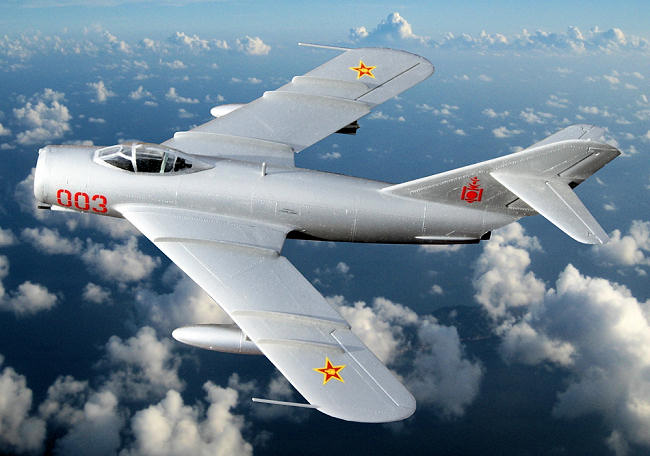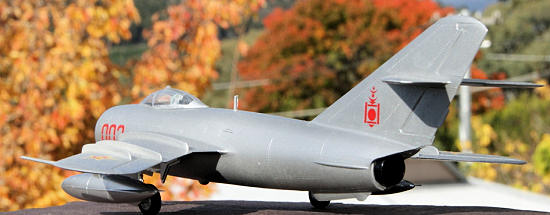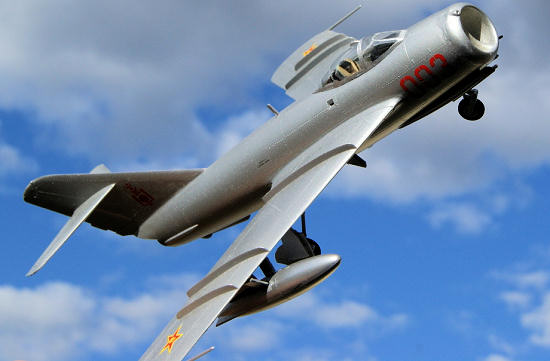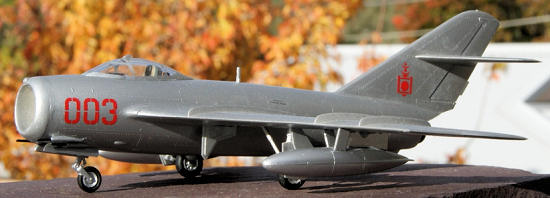
Hasegawa 1/72 MiG-17F
| KIT #: | 02864 |
| PRICE: | $10-12.00 |
| DECALS: | Three options |
| REVIEWER: | Richard F |
| NOTES: | Hi-Line Decal sheet 72030 used |

| HISTORY |
Mongolia's a fantastic and remote country that is
squeezed in between Russia and China. It's as big as western Europe with a
population less than Paris. Since its glory days in the 1200s when Genghis Khan
set up the Mongol Empire, it's not been very powerful or played much of a role
on the world stage. It was absorbed into China's mighty empire until the Qing
Dynasty collapsed in 1911, and then it spent most of the 20th century suffering
under Soviet control. It finally got a real measure of self government again
after the end of the Cold War, and these days gets by on agriculture and mining.
Still a third of its people are nomads, and there is a low-key but booming
tourism industry for people looking for true wilderness experiences on its vast
tundras.
 There's not a lot known about the Mongolian Air Force. It started life on 25 May
1925 when a Junkers F.13 arrived on the scene and for years later it relied on
Russian hand-me-downs. It entered the jet age in 1970 with a small fleet of
MiG-17s, topped up a little later by MiG-21s. According to wikipedia, the
majority of the air force, and all its fast jets, have been grounded for years
for lack of cash and spares. Lately the Mongolian government has been trying to
spruce up the air wing, focusing on cargo operations.
There's not a lot known about the Mongolian Air Force. It started life on 25 May
1925 when a Junkers F.13 arrived on the scene and for years later it relied on
Russian hand-me-downs. It entered the jet age in 1970 with a small fleet of
MiG-17s, topped up a little later by MiG-21s. According to wikipedia, the
majority of the air force, and all its fast jets, have been grounded for years
for lack of cash and spares. Lately the Mongolian government has been trying to
spruce up the air wing, focusing on cargo operations.
Mongolia has been friendly to the West in recent years and sent troops to
Kosovo, Iraq and Afghanistan, as well as Sierra Leone and Chad. Naturally, given
its location, and the size of their economies, Mongolia also seeks good stable
relations with Russia to its north and China to its south.
So much for the Mongolian Air Force and the country it serves. What about the
plane?
Well, most people have heard of the MiG-17. Second in the successful series of
MiG fighter jets, the -17 was a cannon-armed fighter in a guided-missile era.
Over Vietnam, it deuced with US Phantoms and won more than enough to make the US
think twice about its own tactics and equipment. According to wikipedia, North
Vietnamese MiG-17s accounted for 71 US aircraft, including 31 F-4s and and 16
F-105s. For that score, though, they lost 110 MiG-17s. In other parts of the
world, especially the Middle East, it had a mixed career - used widely with
varying degrees of success. In good hands, it was a potent weapon.
The Mongolian MiG-17s served a quiet life, so far as can be told. Mongolia flew
the earlier Fresco-A version.
| THE KIT |
This is Hasegawa's MiG-17 PF kit in the Nguyen
Van Bay boxing, backdated with a metal nose to make it a Fresco A. It's pretty
 standard earlier Hasegawa fare. You can read the preview right here on Modeling
Madness.
standard earlier Hasegawa fare. You can read the preview right here on Modeling
Madness.
Aside from the new nose, this is exactly the same MiG-17 as originally kitted -
that is, the radar equipped MiG-17PF. That means it does not have the smaller
speed brakes of the Fresco A nor does it have the correct canopy as the radar
plane had a longer windscreen with framework not found on the MiG-17A/F
versions. The kit is also probably somewhat over-scale with tail planes that are
a bit too small. None of these should be deal breakers if you can find the kit
at a reasonable price and are not overly concerned about the differences.
The Hasegawa decals are for Nguyen Van Bay's aircraft and another North
Vietnamese example.
| CONSTRUCTION |
 This is a simple kit. A basic cockpit goes together
first but you may want to put some decent detail in there. I just built it
straight from the box and painted on some seatbelts without doing anything more.
After assembling the fuselage and adding the wings, I used some superglue to
attach the white metal nose. It weighs a lot so I didn't add any other
nose-weight. I needed to use some putty and sand paper around this join to
smooth it out.
This is a simple kit. A basic cockpit goes together
first but you may want to put some decent detail in there. I just built it
straight from the box and painted on some seatbelts without doing anything more.
After assembling the fuselage and adding the wings, I used some superglue to
attach the white metal nose. It weighs a lot so I didn't add any other
nose-weight. I needed to use some putty and sand paper around this join to
smooth it out.
The fit is pretty decent for a kit of this age. Other than around the nose, I
didn't need much in the way of putty or sanding. The wings and tailplanes fit
nicely.
I painted my jet then, and once it was dry I went ahead and attached the wheels
and the underwing tanks. At the end, I popped on the canopy and the MiG was
finished. It really was a weekend build.
| COLORS & MARKINGS |
 Mongolian MiG-17s seem to have been silver all over,
so I went with my trusty spray can of Tamiya AS-12. I find it to be a
good-looking finish for a flat aluminium appearance.
Mongolian MiG-17s seem to have been silver all over,
so I went with my trusty spray can of Tamiya AS-12. I find it to be a
good-looking finish for a flat aluminium appearance.
For decals, I used the Hi-Decal Line sheet number 72030. It has 6 MiG-17
options: two Soviet, East German, Afghani, Iraqi and Mongolian.
These decals went on very easily and give me a pretty exotic addition to my
shelf-top flight line, even if the jet itself is a simple silver specimen.
| CONCLUSIONS |
A simple kit, very easy to build. So many countries used the MiG-17 and there must be many other decal sheets with examples used by unusual air forces. Recommended if you want a MiG-17, even if this one isn't 100 per cent accurate, or if you just want a quick weekend build between more serious projects.
| REFERENCES |
This thread has some great historical images of
Mongolian MiG-21s:
http://forum.scramble.nl/viewtopic.php?f=41&t=48713&hilit=mongolian
June 2011
If you would like your product reviewed fairly and quickly, please
contact
me or see other details in the
Note to
Contributors.